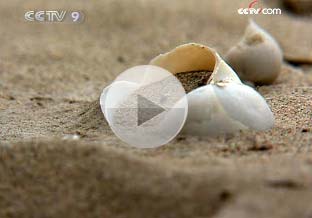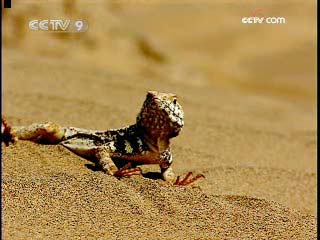------Program code: NS-080825-03416 (what's this?)
Source: CCTV.com
08-25-2008 10:55
 |
The floods still haven’t come. And the seed still doesn’t know its fate.
The morning breeze brings a breath of dampness. The seeds have become lighter.
 |
The seeds that come from the Taklamakan Desert weigh one ten-thousandth of a gram each. Out of the thousands of billions of them, one may grow into the tallest tree in the desert.
A wind suddenly starts up. The seeds start their journey, flying into the distance.
Some seeds fly past the tree with the single branch. They don’t stop, but continue their search for water.
It’s early morning. The air contains the taste of wet soil. The baby black storks are excited by the prospect before them.
With the dry riverbed of the Tarim River filled by the floods, the desert has taken on a new look.
The flood surge this year has left lines on the desert. The flood-land is the cradle of the euphrates poplar.
The young black storks spread their wings for the first time. This is also the first time for them to see a river. The sight awakens memories bequeathed to them by their forefathers.
There are always some among the hundreds of millions of seeds that succeed in flying across the desert and woods to discover the big river that has suddenly appeared.
The midday sun increases the water temperature. Having spent just 6 seconds absorbing sufficient water, the seeds quietly burgeon beneath the surface.
The seed must strike root on the riverbank.
It clutches the sand on the riverbank with its long tentacles.
A thick layer of fallen leaves covers it.
The seed uses every second to sprawl over the soil. If the sunlight is strong tomorrow, the flood-land will probably dry up. If the flood recedes, the seed will have no chance to grow.
The river water doesn’t reach the tall tree with the single branch. It hasn’t seen any flooding for the last forty years. The Tarim River has forgotten this land.
The tall tree with the single branch has found an alternative means of survival.
Its roots produce sprouts, which give birth to the little seedling. But the seedling is still very weak.
To ensure that the seedling has enough water, the big tree must make a choice.
The leaves at the end of its single branch have started to fall because there is not enough water.
On the flood-land of the Tarim River, the seeds have been growing downward.
The burgeoning seeds must strike root soon so that they can spread with the flow of the river water. The roots will then grow many times longer than their trunks.
The seedlings that sprouted last year see the Tarim River for a second time.
After so long, the heat gradually begins to recede. The short autumn arrives. Having enjoyed plenty of water this year, the trees take on a splendid golden yellow colour.
But the river water hasn’t visited the land by the tree with the single branch. So its leaves have a grey tinge.
The baby euphrates poplar is growing stronger with the help of the root system of the tree with the single branch. The temperature is higher on the surface, and its leaves are a little green.
The big tree’s single branch hasn’t received any water for a long time. After the autumn frost, its withered leaves are falling.
It takes an entire autumn for the tree’s single branch to break. With this done, it can live on.
The river water spills over the banks and fills the dry lake beds. This is the water that will sustain the whole desert until the next flood arrives.
The vocal cords of the baby black stork degenerate as it grows mature. Silently, it leaves the desert for the south.
It’s morning. A leaf falls from the top of the female tree.
It flies away on the wind just like countless millions of other poplar leaves have done in the past centuries.
Editor:Yang
